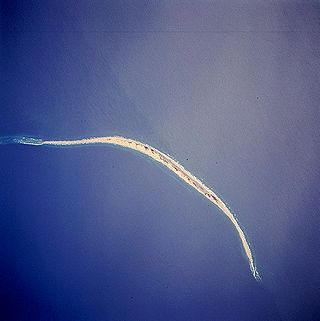
Sable Island is a small Canadian island situated 300 km (190 mi) southeast of Halifax, Nova Scotia, and about 175 km (109 mi) southeast of the closest point of mainland Nova Scotia in the North Atlantic Ocean. The island is staffed year round by three federal government staff, rising during summer months when research projects and tourism increase. Notable for its role in early Canadian history and the Sable Island horse, the island is protected and managed by Parks Canada, which must grant permission prior to any visit. Sable Island is part of District 7 of the Halifax Regional Municipality in Nova Scotia. The island is also a protected National Park Reserve and an Important Bird Area.

A ghost ship, also known as a phantom ship, is a vessel with no living crew aboard; it may be a fictional ghostly vessel, such as the Flying Dutchman, or a physical derelict found adrift with its crew missing or dead, like the Mary Celeste. The term is sometimes used for ships that have been decommissioned but not yet scrapped, as well as drifting boats that have been found after breaking loose of their ropes and being carried away by the wind or the waves.

Laconia was a Cunard ocean liner, built by Swan, Hunter & Wigham Richardson as a successor of the 1911–1917 Laconia. The new ship was launched on 9 April 1921, and made her maiden voyage on 25 May 1922 from Southampton to New York City. At the outbreak of the Second World War she was converted into an armed merchant cruiser, and later a troopship. She was sunk in the South Atlantic Ocean on 12 September 1942 by torpedoes. Like her predecessor, sunk during the First World War, this Laconia was also destroyed by a German submarine. Some estimates of the death toll have suggested that over 1,658 people were killed when the Laconia sank. The U-boat commander Werner Hartenstein then staged a dramatic effort to rescue the passengers and the crew of Laconia, which involved additional German U-boats and became known as the Laconia incident.

USS Bear was a dual steam-powered and sailing ship built with six-inch (15.2 cm)-thick sides which had a long life in various cold-water and ice-filled environments. She was a forerunner of modern icebreakers and had a diverse service life. According to the United States Coast Guard official website, Bear is described as "probably the most famous ship in the history of the Coast Guard."

CCGS Hudson was an offshore oceanographic and hydrographic survey vessel operated by the Canadian Coast Guard. The ship entered service in 1963 with the Canadian Oceanographic Service, stationed at the Bedford Institute of Oceanography, called CSS Hudson. The ship made several significant scientific voyages, among them the first circumnavigation of the Americas in 1970. The ship was transferred to the Canadian Coast Guard in 1996 and decommissioned in 2022. A replacement is not scheduled for delivery until 2024–2025.

Seal Island is an island on the outermost extreme of Southwestern Nova Scotia, Canada, in the Municipality of the District of Argyle in Yarmouth County. It is approximately 4.3 kilometres (2.7 mi) long and 0.8 kilometres (0.50 mi) wide and is surrounded on its east, south and west sides by dangerous shoals. It is surrounded by the Atlantic Ocean and is the biggest of a group of five islands which extend north for 12 kilometres (7.5 mi). It is the second southernmost point of land of Nova Scotia. The southern tip of nearby Cape Sable Island is 250 metres (820 ft) farther south than the southern tip of land on Seal Island.

Theodore Too is a large-scale imitation tugboat built in Dayspring, Nova Scotia in 2000 based on the fictional television tugboat character Theodore Tugboat. Theodore Too was located in Bedford, Nova Scotia but arrived in Hamilton, Ontario, his new home, on July 18, 2021.
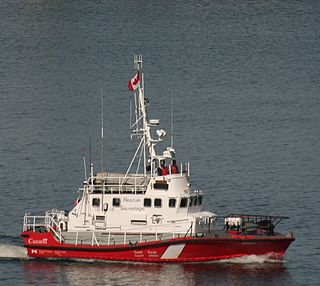
CCGS Sambro is a Canadian Coast Guard motor lifeboat homeported in Sambro, Nova Scotia.
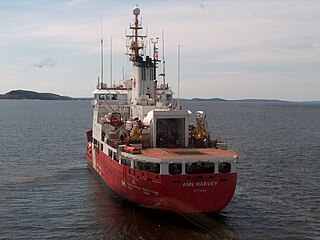
CCGS Ann Harvey is a Canadian Coast Guard buoy tender and SAR vessel with light icebreaker duties. She was constructed in 1987 by Halifax Dartmouth Industries, in Halifax, Nova Scotia. The vessel was named after Ann Harvey, the daughter of a local Newfoundland fisherman who helped rescue 185 people during her lifetime. Ann Harvey's home port is St. John's, Newfoundland and Labrador and is stationed there with other Coast Guard ships.
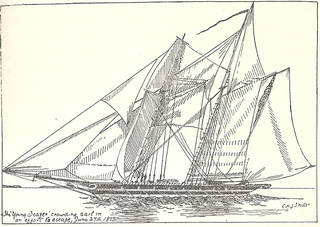
Young Teazer was a United States privateer schooner that captured 12 British vessels, five of which made it to American ports. A member of her crew blew her up at Mahone Bay, Nova Scotia during the War of 1812 after a series of British warships chased her and after HMS Hogue trapped her. The schooner became famous for this deadly explosion, which killed most of her crew, and for the folklore about the ghostly "Teazer Light."

SS Hungarian was a transatlantic steamship of the Canadian Allan Line that was launched in 1858, completed in 1859, and sank in 1860.

CGS Aberdeen was a Canadian Government Ship launched in 1894, which served as a lighthouse supply and buoy vessel. The vessel served on the East Coast of Canada until 1923, when the vessel ran aground on Seal Island, Nova Scotia.

HMS Mosquidobit was the Chesapeake-built six-gun schooner Lynx that the British Royal Navy captured and took into service in 1813. She was sold into commercial service in 1820 and nothing is known of her subsequent fate.
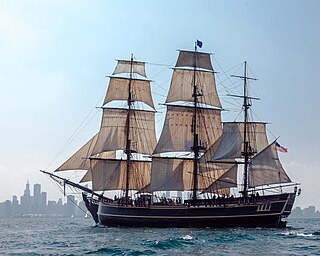
Bounty was an enlarged reconstruction of the original 1787 Royal Navy sailing ship HMS Bounty, built in Lunenburg, Nova Scotia, in 1960. She sank off the coast of North Carolina during Hurricane Sandy on October 29, 2012.

Acushnet – a steel-hulled revenue cutter – was launched on 16 May 1908 at Newport News, Virginia, by the Newport News Shipbuilding and Drydock Co.; sponsored by Miss Alayce Duff; and commissioned at Baltimore on 6 November 1908. She saw service as a United States Revenue Cutter Service cutter, a U.S. Navy fleet tug, and as a U.S. Coast Guard cutter. She was taken out of service 8 January 1946.
Governor Parr was a four-masted schooner built in Parrsboro, Nova Scotia in 1918. Built by W.R. Huntley & Sons for Archie Davidson and Captain Angus D. Richards, she is claimed to be the "most handsome schooner built in Atlantic Canada" and was also the last schooner built in Parrsboro. She was named after early Governor of Nova Scotia John Parr.
Codseeker was a Canadian fishing schooner launched in April 1877 and capsized the following month east of Cape Sable Island, at the southwestern tip of Nova Scotia, resulting in the loss of four lives. The ship is primarily remembered for its two crew members who remained trapped inside the hull until being rescued three days later. Codseeker was later repaired and returned to service; its ultimate fate is unclear.
The FV Flora Alberta was a Canadian auxiliary fishing schooner based out of Lunenburg, Nova Scotia. She was launched in 1941 by Smith and Rhuland, the company's 187th vessel. The managing owner of the vessel was fishing company Adams & Knickle.

The Battle of Blomidon took place on 21 May 1781 during the American Revolutionary War. The naval battle involved three armed U.S. privateer vessels against three Nova Scotian vessels off Cape Split, Nova Scotia. American Privateers caught two Nova Scotia Vessels. The first Nova Scotia vessel was re-captured by Lieut Benjamin Belcher. The second Nova Scotia vessel was overtaken by the captured crew under the command of Captain Bishop. The privateers were taken to Cornwallis and put on trial.
















